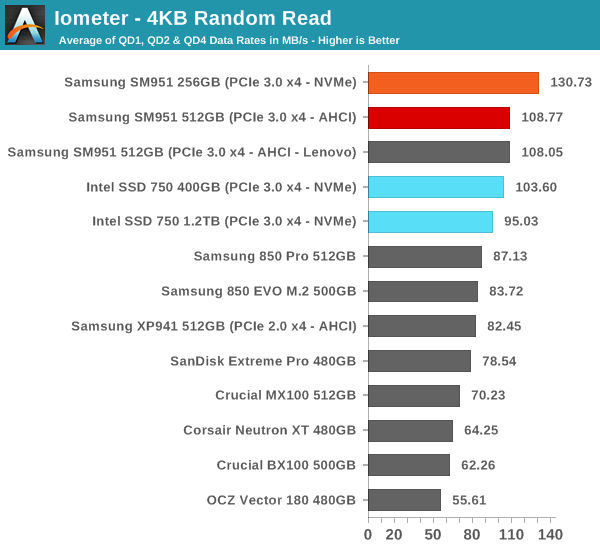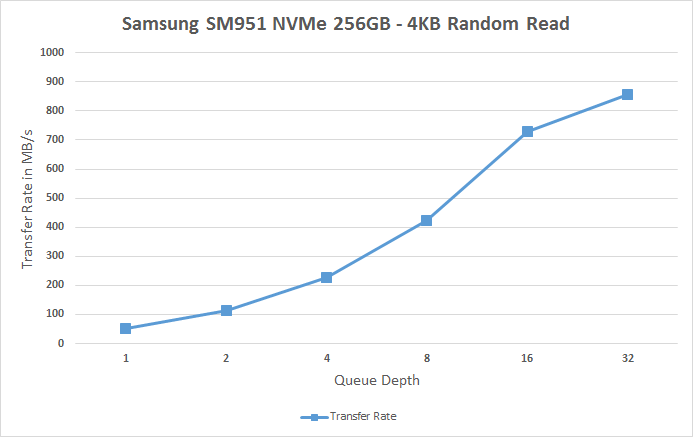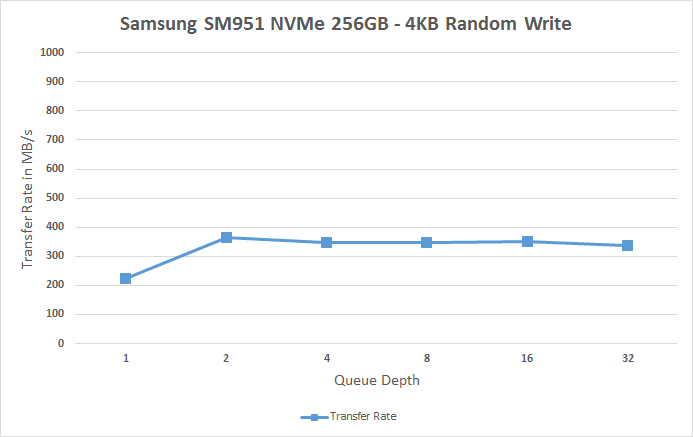Samsung SM951-NVMe (256GB) PCIe SSD Review
by Kristian Vättö on June 25, 2015 9:40 AM ESTRandom Read Performance
For full details of how we conduct our Iometer tests, please refer to this article.

This is the graph I've been dying to see ever since I first heard about NVMe. Random read performance at low queue depths was mostly bottlenecked by AHCI latency because at QD1 the controller can only read from one NAND die (it's asked to read one 4KB chunk of data at a time), meaning that a tremendous share of the latency was caused by the command overhead. As the NVMe command set is much simpler and the whole IO stack is lighter, it opens the doors for improved low queue depth performance, which is exactly what we are seeing with the SM951 NVMe.
 |
|||||||||
| Default | |||||||||
At QD1 the SM951 NVMe offers about 50MB/s, whereas the best AHCI drives I've seen hover around 30-35MB/s, resulting in about 50% gains. Performance at QD2 and QD4 is also better than what other drives offer and in general the SM951 NVMe has excellent random read performance including the high QDs as well.
Random Write Performance

NVMe doesn't present similar gains to random write performance, though. This is an area where Intel clearly has an advantage, but given that the SSD 750 carries an 18-channel controller that is hardly a surprise. Moreover, because the SSD 750 features full power loss protection Intel can cache more user data in the DRAM buffer without the risk of data loss, which can further improve random write performance as IOs can be combined more efficiently. Intel's custom driver may also help with random write performance because the native Microsoft driver has some write performance issues due to Force Unit Access (basically FUA won't consider write to be complete until it has been written to its final medium i.e. NAND, whereas Intel's driver can consider write to be complete when it reaches the DRAM buffer).
 |
|||||||||
| Default | |||||||||










74 Comments
View All Comments
Dasa2 - Monday, June 29, 2015 - link
i would also like to know how cpu usage is affectedit may not be of any significance with a 4790k but with a i3\i5nuc?
i would also be interested to see if ram speed has any effect on such high speed ssd speed in a nuc since most people seem to buy 1600c11 sodimm for them
iwod - Thursday, June 25, 2015 - link
What is stopping us to getting a 32 Channel SSD Controller?Cost? Or we wait for 3D NAND to push to the max 3.2GB/s a PIC-E 3.0 x4 allows?
What's next then? PCI-E 4.0 isn't even on the Cannonlake Roadmap.
And even with the 4x PCI-E 4.0 it seems to be too little headroom for SSD.
Where is the next bottleneck?
Kristian Vättö - Friday, June 26, 2015 - link
There are some 32-channel controllers in the enterprise space, but as you suspected the reason why we don't see those in the client market is cost.Right now I would say the biggest bottleneck is software design because everything (except some enterprise applications) is still designed for high latency storage (i.e. load everything to RAM and as little disk access as possible, whereas by properly utilizing the low latency of SSDs applications performance could be improved.
stevae - Friday, June 26, 2015 - link
OK, so a couple of things here. first, while windows 10 10130 is still a little buggy, i already have 10147 and it is rock solid. many improvements. next, i am running it on a samsung 951. boots very nice, there is no more error when restarting like there was in 10130, and things are smooth. however, it doesn't run at full speed. on crystal disk mark i get 1569 sequential read, and 1474 sequential write. and my sm951 is the ahci version. but this leads me to the BIG quesiton, since you guys said that the hardware is the same between the ahci and nvme versions, does that mean when the nvme version comes out and is sold widely, that i can download firmware to turn my ahci version into a nvme version?yeeeeman - Friday, June 26, 2015 - link
These SSDs are good for driving the performance up, especially for datacenters. In home usage, I swear that a Samsung 840 PRO is gonna satisfy all your hidden performance dreams. Period.JKJK - Friday, June 26, 2015 - link
You really didn't get the low-queue-depth-performance-and-low-latency-for-client-workloads-part, did you?I'm going to get me a few of these, as soon as they're available.
Shinzon - Friday, June 26, 2015 - link
I just build new main desktop and added also a 951 AHCI version and the difference from my 840 pro to this is very noticeable, almost as from mechanic drive to a SSD all over again. I can even feel the difference from the 951 and to my 2 840 pros in raid 0. So that comment is not very professional :-)Shinzon - Friday, June 26, 2015 - link
@ Kristian VättöAs someone else already speculated, could we please research some more if the AHCI version can be re flashed to NVMe version ? Of course Samsung answer will be: not supported because it's OEM product, warranty void and the whole swada but I guess it's a question of getting a flash program that supports the controller EPROM they use and copy the NVMe firmware and then reflash the AHCI version. I think many would be interested in this.
Tack för dina altid fina reviews :-)
dcaxax - Friday, June 26, 2015 - link
Two words about Samsung SSD's. Never. Again.stevae - Friday, June 26, 2015 - link
yeah, why would you. they only lead the ssd world 95% of the time. sure, you go ahead and stick with that ocz crap.